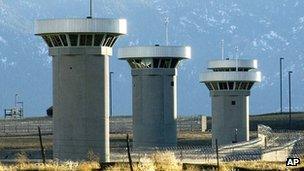Just how bad are American 'supermax' prisons?
- Published

No inmate has ever escaped from an ADX prison
The European Court of Human Rights has rejected arguments by Babar Ahmad and three other terror suspects that they could face ill treatment in a "supermax" American high-security prison.
But what is life like in the "Alcatraz of the Rockies" and why was the court not convinced?
The Administrative Maximum facility (ADX), or "supermax" prison in Florence, Colorado, holds some of the most notorious American terrorists and murderers in solitary confinement.
The prison is home to about 360 inmates held under ultra-high security.
It is here, the suspects argued, they could end up if found guilty of terrorism in the US.
High-profile terrorists
But the European Court of Human Rights found that a life sentence in the prison would be justified.
According to the court: "If the applicants were convicted as charged, the US authorities would be justified in considering them a significant security risk and in imposing strict limitations on their ability to communicate with the outside world."
Based on evidence from the US Department of Justice and statements from the American prison, the court said conditions in the jail would not breach human rights.
The prison, known for its high-profile inmates, small cells and restrictions on contact with the outside world, has an infamous international reputation: mainly because of its policy of holding its inmates in almost permanent solitary confinement.
The facility, 108 miles (173km) from Denver, holds convicted terrorists, militant anti-government extremists, gangsters, and other criminals considered so violent and dangerous mere maximum-security prison is not safe enough.
"We have only the most violent, disruptive and escape-prone inmates in the federal system," says Mark Collins, a spokesman for the prison.
Most of the prisoners are locked in spartan, 87-sq ft (8-sq m) cells; those under the strictest conditions are allowed out for as little as an hour a day, Mr Collins says.
Contact with other human beings is strictly limited - mostly to prison guards, counsellors and other staff.
Inmates who follow the rules can be rewarded with further time out of their cells and more opportunities to interact with other prisoners, Mr Collins says.

The prison is remote and isolated from the outside world
But current and former inmates, lawyers and others familiar with the prison describe it as an infernal environment in which even the design of the cells and the architecture of the prison conspire to render the inmates docile and drive them mad.
"People talk about it as being a cleaner version of hell," says Colin Dayan, a professor of English at Vanderbilt University and author of The Law Is a White Dog: How Legal Rituals Make and Unmake Persons, who has studied high security prisons in the US.
"It's immaculate. It's no black hole. It's not your typical sense of the hole of solitary confinement. You are staring upon nothingness: Concrete all the time. The architecture itself is the form of the torture."
It is this reputation that lawyers for Babar Ahmad, Syed Tahla Ahsan, Adel Abdul Bary and Khaled Al-Fawwaz used in their defence.
According to the court, US Authorities would consider it impossible to detain Abu Hamza, the fifth suspect, at the supermax prison "because of his disabilities (particularly the amputation of his forearms)".
Lawyers for the other four suspects argued that the tough prison conditions would amount to "inhuman or degrading treatment or punishment", under the Human Rights Act.
Last week Babar Ahmad told the BBC: "I am facing extradition to the United States and spending the rest of my life in solitary confinement."
But the court's judgement said that the facilities for prisoners, including television, radio, newspapers, books and telephone calls, "went beyond what was provided in most prisons in Europe".
'Horrifying cases'
In its ruling the court pointed out that "not all inmates convicted of international terrorism were housed at ADX". The judgement said "procedural safeguards" are in place for prisoners and that they can bring claims to the attention of US authorities.
But Dr Sharon Shalev, a criminologist at the London School of Economics, who has visited American high-security facilities, said: "Supermax prisons are very extreme. I have a feeling the courts don't realise how extreme they are. I've yet to see a European prison as extreme.
"Prisoners spend most of the day inside a small cell with no view and no contact with other humans. Everything is done from inside the cell.
"Even during medical treatment doctors stand at the gate of the cell. American authorities would have you believe this is meaningful human contact."
Dr Shalev said she had seen "horrifying cases" of people who went into prison sane, but ended up self-harming and attempting suicide as a result of solitary confinement.
Ray Luc Levasseur, a former inmate at ADX Florence Penitentiary in Colorado, told the Today programme: "It doesn't always stop with damage... it doesn't always have to stop with the mind.
"It can move on into degrading your soul, your spirit. And a prisoner who's been damaged like this - from point of view of the prison wardens - that prisoner is more controllable, more manageable."
- Published10 April 2012
- Published5 October 2012
- Published10 April 2012
- Published5 April 2012
- Published5 April 2012